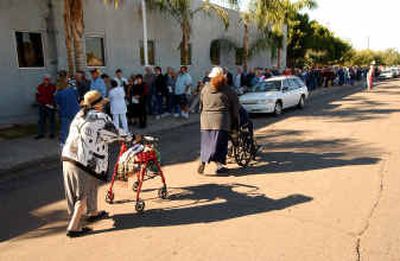Stretching vaccine not safe for seniors

New research suggests that giving flu vaccine in a novel way can stretch doses and protect more people, but it didn’t work as well in those over 60 and is too experimental to be used to ease this year’s shortage, experts say.
Scientists tested giving smaller doses of vaccine into the skin instead of full doses given as traditional shots into a muscle. Young people had comparable immune system responses but older people, who are most at risk of dying from flu, did not.
Just measuring response alone doesn’t prove effectiveness or justify changing recommendations for this flu season, said Dr. Myron Levin of the University of Colorado School of Medicine, who is chairman of the government’s vaccine advisory panel.
“What nobody knows is whether or not they’re going to be just as protective,” said Levin, who had no role in the two new pilot studies.
Results were published online Wednesday and will appear in the New England Journal of Medicine’s Nov. 25 edition.
The skin method is used for tuberculosis tests but isn’t licensed for giving flu or any other vaccine. Because of the severe flu shot shortage this year, some doctors may opt to use it anyway on some people, such as health care and day care workers, said Dr. Robert Belshe of St. Louis University, who led one of the studies.
His team gave full doses of Aventis Pasteur flu shots to 119 people and 40 percent doses of an experimental GlaxoSmithKline vaccine into the skin of 119 others. The vaccine used in the research contained strains from the 2001-2002 season.
Antibody responses were similar in people ages 18 to 60, but were 75 percent lower in older study participants, Belshe said.
Glaxo funded the study, and Belshe and other authors have been consultants for Glaxo, Aventis and other vaccine-related businesses.
The new findings “are very exciting but they are still very early” and need to be tested in larger studies that include more older people and those with other health problems, said Dr. Mitchell Cohen, director of the Centers for Disease Control and Prevention’s Coordinating Center for Infectious Disease.
The second study was led by Dr. Richard Kenney of Iomai Corp., a Gaithersburg, Md., company that is developing skin vaccination technology. That experiment compared traditional flu shots to one-fifth doses given through the skin in 100 healthy 18- to-40-year-olds and found comparable or better responses from skin.
That study was partly funded by the National Institute of Allergy and Infectious Diseases. Its director, Dr. Anthony Fauci, and another federal vaccine expert, John LaMontagne, write in an accompanying editorial that the skin method is encouraging and merits more study.
It seems to generate not just antibodies to flu, as traditional flu shots do, but also a second response by specialized immune system cells — findings that “raise provocative issues” about whether the skin method ultimately may prove better for the elderly, who have a poor antibody response to flu shots now, they write.
Shortly after the editorial was released, news came that LaMontagne had collapsed and died late Tuesday at an airport in Mexico City where he had traveled for a government health meeting. LaMontagne, 61, was deputy director of the allergy institute.